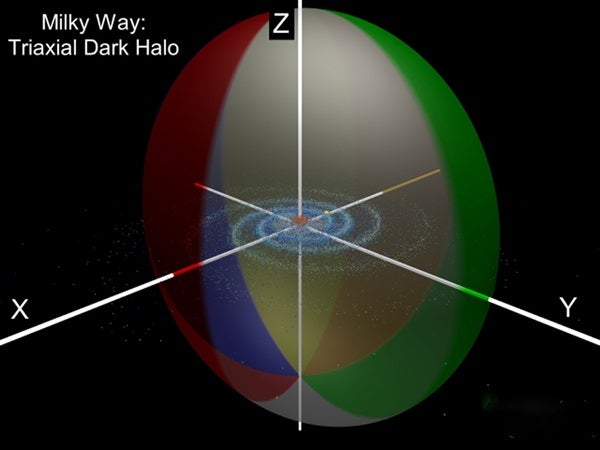The halo of dark matter surrounding our Milky Way Galaxy is shaped something like a gigantic, flattened cosmic beachball, astronomers announced today, January 6. This result is important because it is the first time that the three-dimensional shape of an individual dark matter halo has been conclusively measured.
Dark matter halos account for more than 70 percent of the mass in galaxies such as the Milky Way, but this dark matter is invisible; all we see when we look up in the sky is the small amount of stars and gas sitting in the centers of these haloes. So how do astronomers see invisible dark matter? It might not be possible to detect it through normal means, but dark matter obeys the laws of gravity and tugs on small dwarf galaxies as they orbit around the Milky Way. By observing the orbits that these dwarf galaxies follow, astronomers can deduce where the dark matter must be using Newton’s law of gravity.
While it would take roughly a billion years to watch a typical dwarf galaxy orbit just once around our home galaxy, dwarf galaxies get shredded by tidal forces as they orbit the much more massive Milky Way and leave stars like breadcrumbs along their path. These stellar breadcrumbs can be traced in huge astronomical surveys such as the Two-Micron All Sky Survey and the Sloan Digital Sky Survey and can therefore be used to infer the orbits of their parent dwarf galaxies.
Using observations of such tidal debris from a dwarf known as the Sagittarius Dwarf Galaxy, astronomers have been able to reconstruct the orbit of Sagittarius and derive models for the Milky Way and its dark matter halo. These models had met an impasse, however: Different parts of the orbit suggested wildly different solutions. “Until recently,” said Law, “we simply didn’t understand why the Sagittarius stream of stars behaves as it does.”
In September 2009, Law and colleagues Majewski and Johnston suggested a solution. By allowing the dark matter halo to be triaxial — to have different axis lengths in all three dimensions — it is possible to fit the entire orbit of Sagittarius simultaneously. The proposed solution suggests that the invisible dark matter halo of the Milky Way can be visualized as some kind of cosmic beachball that has been squashed sideways. “At last we have a way of explaining what previously seemed like conflicting information about the Sagittarius system,” said Majewski. The fact that the cosmic beachball was squashed from the side came as a surprise. It suggests that the dark matter halo and the disk of stars in the Milky Way are oriented roughly perpendicular to each other. “We expected some amount of flattening based on the predictions of the best dark matter theories,” said Law, “but the extent, and particularly the orientation, of the flattening was quite unexpected. We’re pretty excited about this because it begs the question of how our galaxy formed in its present orientation.”
“Sagittarius is only one of many dwarf galaxies surrounding the Milky Way, and it will be important to see if these results hold up as precise orbits are measured for more of these galaxies,” said Law. “In the meantime, such a squashed dark-matter halo is one of the best explanations for the observed data.”










